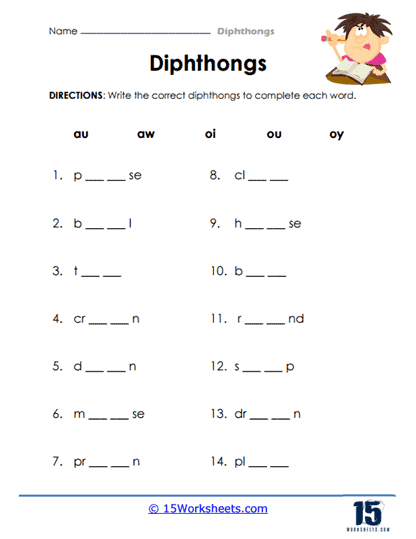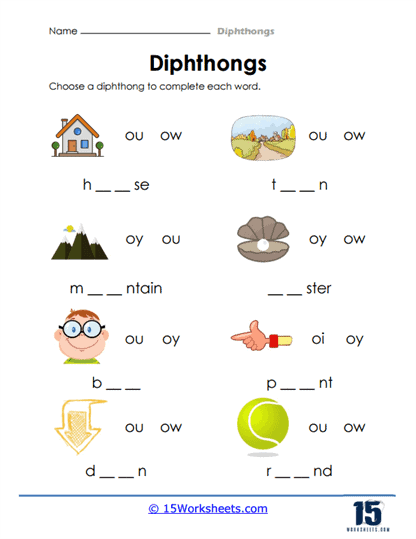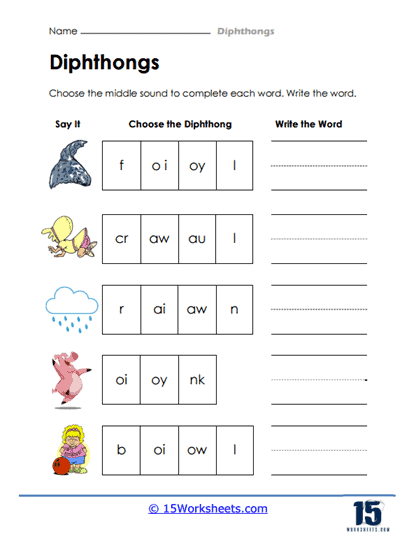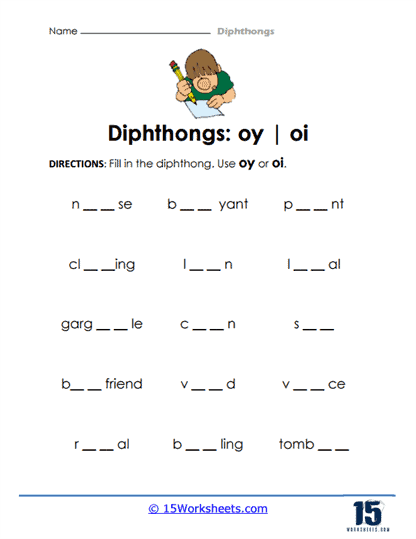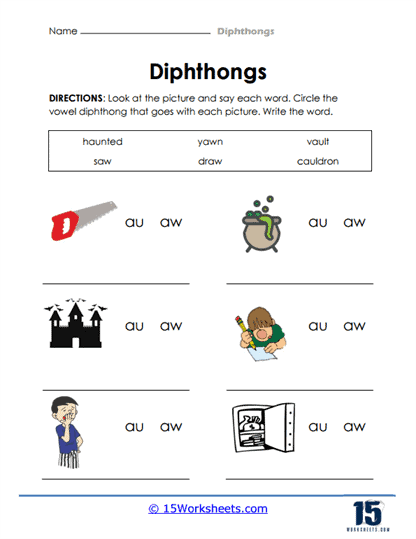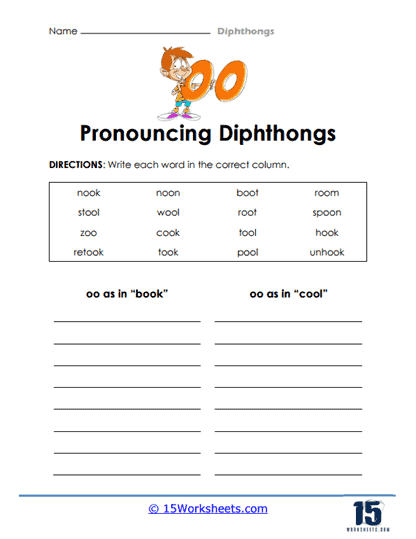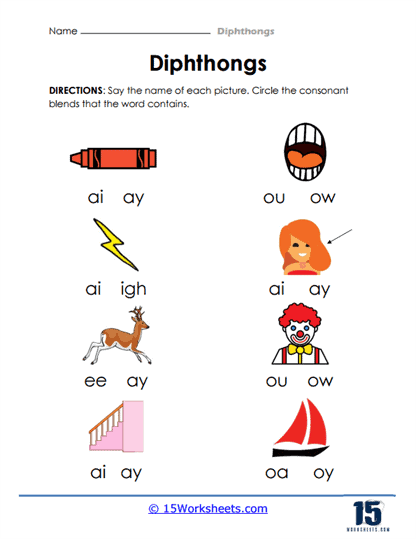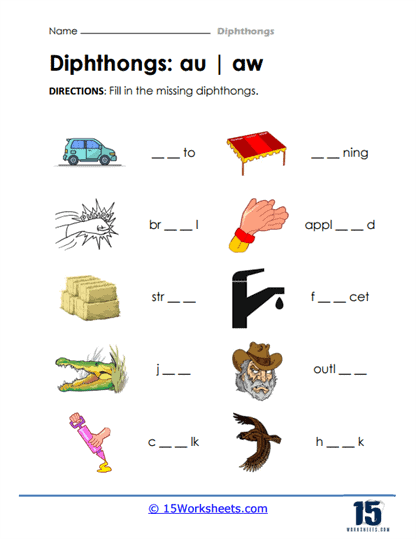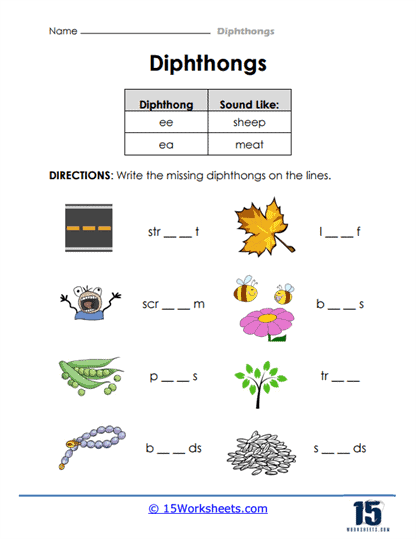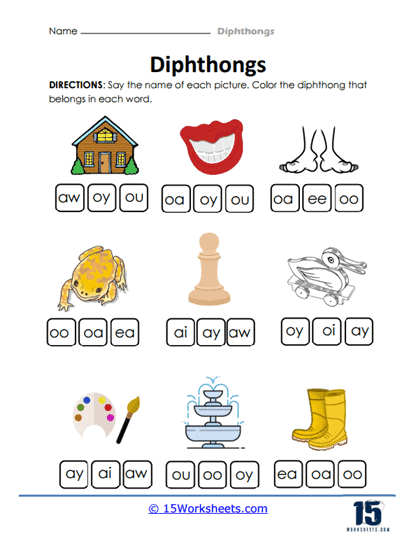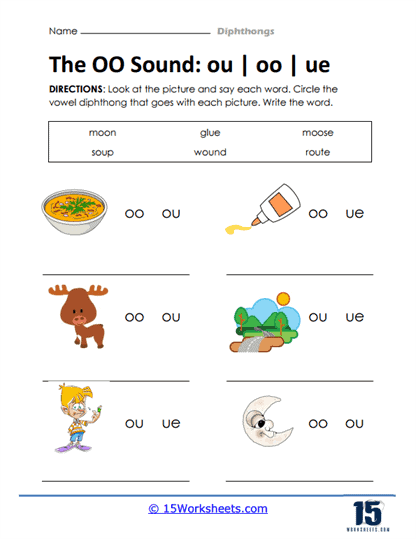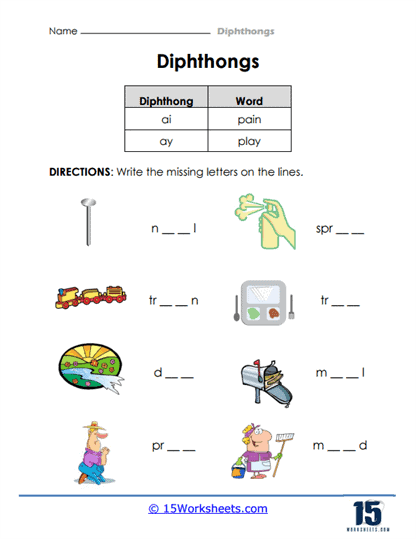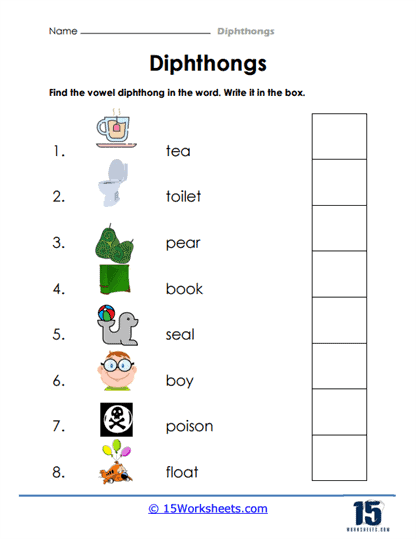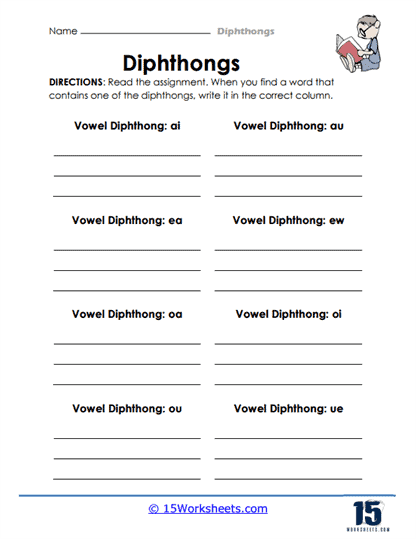Diphthongs Worksheets
All About These 15 Worksheets
Diphthongs are the building blocks of fluent reading and effective communication, making a solid understanding of them essential for any young learner. This collection of diphthongs worksheets is more than just a set of practice pages-it’s a gateway to phonetic mastery, designed to guide students through the intricacies of diphthongs with clarity and engagement. Each worksheet in this series is thoughtfully crafted to not only introduce students to these unique vowel combinations but also to provide ample opportunities for practice and application, ensuring that learning is both comprehensive and enjoyable.
Diphthongs, the blend of two vowel sounds within a single syllable, are a cornerstone of phonics instruction. They allow readers to glide seamlessly from one vowel sound to another, forming words that are integral to everyday language. These vowel blends, such as “oi” in “coin” or “ou” in “house,” can be tricky for early readers, which is why mastering them is so crucial. Without a firm grasp of diphthongs, students may struggle with reading fluency, word recognition, and spelling accuracy—skills that are vital for success in literacy and beyond. The diphthongs worksheets in this collection are therefore an invaluable tool for educators and students alike, serving as a bridge between foundational phonics and advanced reading capabilities.
But what exactly are diphthongs, and why do they matter so much? At their core, diphthongs are combinations of two distinct vowel sounds that merge within a single syllable. This seamless transition from one vowel to another creates a sound that’s more dynamic and fluid than a simple, singular vowel. For instance, in the word “now,” the “ow” sound begins with the “ah” sound and glides into the “oo” sound. Similarly, “coin” begins with the “oh” sound and transitions into the “ee” sound. These blends are found in countless words that students encounter daily, which is why understanding them is a key to unlocking reading fluency and spelling competence.
The diphthong worksheets included in this resource are designed with intentional diversity and creativity, ensuring that students can engage with the material in multiple ways. From matching exercises that require students to pair diphthongs with corresponding words, to sorting activities where students categorize words based on their diphthong sounds, each worksheet offers a new and exciting challenge. These activities not only reinforce phonetic concepts but also help students develop stronger listening and spelling skills. Writing exercises encourage students to apply their knowledge, ensuring that they can not only recognize diphthongs but use them correctly in their own writing.
These worksheets are versatile and adaptable, making them ideal for use in a variety of educational settings. Whether used as part of a classroom lesson, as homework, or in small group work, they provide educators with the flexibility to tailor their instruction to meet the unique needs of their students. For young learners, these worksheets transform phonics instruction into a fun and interactive experience, allowing them to build confidence in their reading abilities while developing a deep understanding of diphthongs.
This collection of diphthongs worksheets goes beyond rote memorization or repetitive practice. It invites students to explore the dynamic world of vowel sounds, deepening their phonetic awareness while fostering a love for language. Through engaging activities and thoughtful design, these worksheets ensure that students not only master diphthongs but also develop a strong foundation for all their future reading and spelling endeavors. This resource empowers educators to unlock the full potential of their students, guiding them toward literacy success one diphthong at a time.
What are Diphthongs?
Diphthongs are complex vowel sounds that occur when two vowel sounds are combined within the same syllable. During the pronunciation of a diphthong, the vocal tract changes shape, causing the sound to glide from one vowel sound to another. Diphthongs are important in phonics and language learning as they help children understand the various ways vowel sounds can combine and change within words, ultimately improving their reading, writing, and pronunciation skills.
Some common diphthongs in English include:
“ou” as in “house” (sound – /aʊ/)
“oy” as in “boy” (sound – /ɔɪ/)
“oi” as in “coin” (sound – /ɔɪ/)
“ow” as in “cow” (sound – /aʊ/)
“aw” as in “saw” (sound – /ɔː/)
“ay” as in “play” (sound – /eɪ/)
“ey” as in “they” (sound – /eɪ/)
“ea” as in “hear” (sound – /ɪər/)
“ie” as in “tier” (sound – /ɪər/)
Teaching children about diphthongs involves helping them recognize and differentiate these combined vowel sounds in words. By practicing the pronunciation of diphthongs, they can develop a more nuanced understanding of the English language and improve their reading and speaking abilities.
The Importance of Diphthongs
Diphthongs hold a central position in the realm of phonics and language acquisition. Here’s why mastering diphthongs is of paramount importance:
- Phonetic Awareness: Developing an awareness of diphthongs helps students identify and manipulate specific vowel sounds within words, enhancing their overall phonemic awareness.
- Word Decoding Mastery: Proficiency in recognizing and pronouncing diphthongs is essential for accurate word decoding, leading to improved reading fluency.
- Spelling Proficiency: Understanding diphthongs assists students in spelling words correctly by representing specific vowel combinations accurately.
- Vocabulary Enrichment: Proficiency in diphthongs enables students to learn and understand a wide range of words and their phonetic patterns, enriching their vocabulary.
- Reading Comprehension: Recognizing diphthongs enhances reading skills, allowing students to decode words quickly and accurately, leading to better comprehension of texts.
- Phonemic Awareness: Engaging with diphthongs promotes phonemic awareness as students learn to distinguish and manipulate complex vowel sounds.
- Early Literacy Support: Proficiency in diphthongs is a valuable approach for early literacy intervention, helping educators identify and address difficulties in reading readiness.
Incorporating diphthongs into phonics instruction provides children with a more comprehensive understanding of the English language’s sound system. By mastering diphthongs, children can improve their reading, writing, pronunciation, and overall language skills.
This collection of Diphthongs worksheets is an invaluable resource that equips educators to guide their students toward phonetic excellence. By engaging with these worksheets, students not only develop a strong foundation in diphthongs but also enhance their reading, spelling, and overall language proficiency.
This collection empowers educators to nurture young learners on their journey to becoming confident and proficient readers and communicators, capable of navigating the complexities of the English language with ease.

